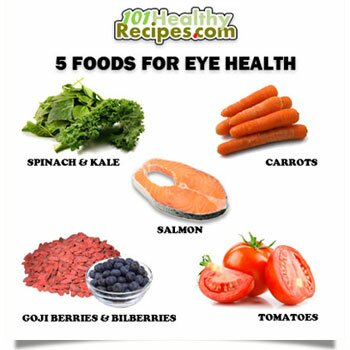List of 5 Great Foods that Protect Your Vision and Maintain Eye Health
-
Leafy Greens such as Spinach and Kale
Spinach, kale and other leafy greens are good for your eyes as they are high in a carotenoid compound known as lutein, which helps prevent cell damage. Spinach can effectively protect the macula (middle of retina) from damage, save you from serious eye diseases such as cataracts and age-related macular disease (ARMD). For sure, if you have family history of ARMD or you are currently suffering from ARMD, you should consider include more spinach and kale in your diet.
-
Carrots
Carrots are well-known for their beta-carotene content. It is a carotenoid pigment that is found mainly in fruits and vegetables with orange color. Beta-carotene is converted to vitamin A in your body and deficiency of vitamin A can cause eye defects including blindness. This orange-colored vegetable also contains lutein, which is able to raise pigment density in your macula and further prevent the eyes from ARMD.

-
Salmon
Salmon has an abundance of Omega-3 fatty acids compared to other fish or seafood. According to scientific studies, people who consume more Omega-3 fatty acids in their daily diet are at lower risk of getting chronic dry eyes and ARMD. To prevent ARMD, it is suggested that a person should eat at least two servings of salmon per week.
-
Berries such as Wolfberries and Bilberries
Research has shown that goji berries or wolfberries are effective in preventing the development of drusen, which are small white or yellow accumulations on both eyes that often happen to people who are at the age of 40 and above. The large amount of drusen may further cause ARMD. A study in 2011 proved that intake of wolfberry supplement for 90 days had helped reduce drusen buildup in a group of aging adults.
The merits of bilberry on vision have been recognized since long ago, and have been justified recently by related scientific research. The berries have been proven by preliminary clinical studies to be able to minimize the symptoms that occur from extended use of computer. In addition, it helps protect you from eye disease like glaucoma by promoting blood vessel integrity within your eyes. Bilberries are also believed to be capable of lowering the risk of cataracts by stabilizing connective tissues as well as minimizing the possibilities of diabetic retinopathy.
-
Tomatoes
Tomatoes contain a pigment carotenoid known as lycopene, besides lutein, alpha-carotene and beta-carotene. Lycopene is responsible for the red color of tomatoes. When a tomato is redder, that means it contains more lycopene. Research has linked the levels of lycopene in a person’s body with reduced risks of cancers of cervix, lungs, breasts, prostate and digestive tract as well as ARMD and cardiovascular disease. Lycopene is found largely in ciliary body and also retinal pigment epithelium, prompting the scientists to believe that the compound, along with lutein and zeaxanthin, is an important factor in preventing cataracts, ARMD and other eye diseases.
|